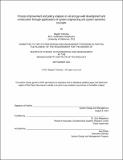Process improvement and policy analysis in oil and gas well development and construction through applications of system engineering and system dynamics concepts
Author(s)
Toleubay, Bagdat
DownloadThesis PDF (10.08Mb)
Advisor
Rebentisch, Eric
Terms of use
Metadata
Show full item recordAbstract
Ever since the boom in unconventional oil and gas reservoir development, an increasing number of companies started to employ a manufacturing philosophy and use factory-like models in asset development. This thesis seeks to provide an overview of the main development processes and, with the help of system engineering and system dynamic concepts, model the dynamic behavior of the well factory. Additionally, main process improvements were identified in the development of the unconventional plays and were implemented in the system dynamic model. It was shown that increasing organizational capability positively affects the selected performance metrics of a well factory. The thesis describes three main aspects of the well factory: 1) well manufacturing assembly line; 2) hydrocarbon production; 3) cash generation. Each aspect has a detailed analysis of supporting subsystems and effects of subsystem-to-subsystem interface variables on the well factory. Organizational forgetting is introduced as a significant impactor on the well factory performance metrics. It was shown that even though there are short-term gains, there is potential for a significant impact in the long run due to descoping of resources and teams. The simulations also show how an accumulation of certain inventories reduces well factory performance and how improvement in certain aspects of the well factory would not necessarily lead to improvement in value generation.
There are six main objectives for this study to help support the model building and analysis: 1) Investigate applicability of lean manufacturing concepts on the well delivery process; 2) Identify main value generation drivers for unconventional play asset development and their effects on the well factory; 3) Reveal research gaps with respect to system dynamic applicability to model a well factory; 4) Tie the well delivery model to cash flow and value generation; 5) Identify existing process improvement initiatives in the industry and tie them to the dynamic model of the well factory; 6) Analyze how learning and increasing organizational capability affects the well factory dynamics.
It was found there are benefits in applying system engineering and dynamics concepts to analyze policies on process improvement and decision making. Actionable recommendations were advised at the end of the study with the assistance of the system dynamic model of the well factory.
Date issued
2021-09Department
System Design and Management Program.; System Design and Management Program.Publisher
Massachusetts Institute of Technology